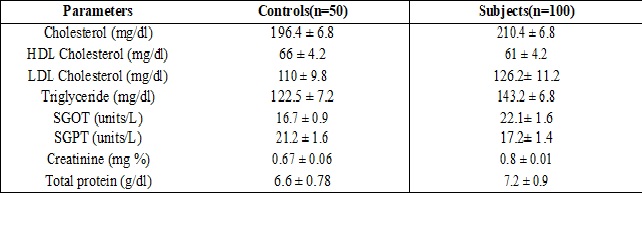Diagnostic value of serum adenosine deaminase in Type 2 diabetic patients
Abstract
Background: Adenosine deaminase (ADA) is suggested to modulate the bioactivity of insulin, but its clinical significance in Type 2 diabetes mellitus (DM) is not yet established. The present study was undertaken to evaluate serum ADA activity and serum uric acid levels in patients of Type 2 DM.
Aim: To evaluate the serum ADA level and to correlate ADA levels with Blood Glucose, Glycated Hemoglobin (HbA1c) levels in Type-2 DM patients.
Material and Method: It is a case control study. The subjects in this study were divided into 3 groups. Group I consisted of 50 normal healthy individuals who served as controls with no history of DM. Group II consisted of 50 patients of Type 2 DM both males & females in the age group of 40-65 years on oral hypoglycemic drugs with HbA1c <7%. Group III consisted of 50 patients of Type 2 DM both males & females in the age group of 40-65 years on oral hypoglycemic drugs with HbA1c >7 %. Serum levels of fasting blood sugar, HbA1c, ADA and uric acid were estimated in all the subjects.
Results: FBS, HbA1c, ADA and serum uric acid levels were found to be increased in the patients of Type 2 DM as compared with controls.
Conclusion: It is concluded that there is an increase in serum ADA levels with increase in HbA1c levels. Serum uric acid levels increased with moderately increasing levels of HbA1c <7% and then decreased with further increasing levels of HbA1c >7% (a bell-shaped relation).
Downloads
References
Nathan DM; DCCT/EDIC Research Group. The diabetes control and complications trial/epidemiology of diabetes interventions and complications study at 30 years: overview. Diabetes Care. 2014;37(1):9-16. doi: https://doi.org/10.2337/dc13-2112.
Bobb A, Gale D, Manmohan S, et al. The impact of the chronic disease assistance plan (CDAP) on the control of type 2 diabetes in Trinidad. Diabetes Res Clin Pract. 2008 Jun;80(3):360-4. doi: https://doi.org/10.1016/j.diabres.2007.11.010. Epub 2008 Apr 14.
Vineet Kumar Khemka, Debajit Bagchi, Arindam Ghosh, Oishimaya Sen, Aritri Bir, Sasanka Chakrabarti, and Anindita Banerjee. Raised Serum Adenosine Deaminase Level in Nonobese Type 2 Diabetes Mellitus. The Scientific World Journal Volume 2013: 1-5.
Hoshino T, Yamada K, Masuoka K, et al. Elevated adenosine deaminase activity in the serum of patients with diabetes mellitus. Diabetes Res Clin Pract. 1994 Sep;25(2):97-102.
Sullivan JL, Osborne WR, Wedgewood RJ. Adenosine deaminase activity in lymphocytes. Br J Haematol. 1977 Sep;37(1):157-8.
Prakash MS, Chennaiah S, Murthy YSR, et al. Altered adenosine deaminase activity in Type 2 diabetes mellitus. JIACM 2006; 7(2): 114-117.
Angielski S, Jakubowski Z, Pawelczyk T, et al. Renal handling and metabolism of adenosine in diabetic rats. Contrib Nephrol. 1989;73:52-7; discussion 57-8.
Lee JG, Kang DG, Yu JR, et al. Changes in Adenosine Deaminase Activity in Patients with Type 2 Diabetes Mellitus and Effect of DPP-4 Inhibitor Treatment on ADA Activity. Diabetes Metab J. 2011 Apr;35(2):149-58. doi: https://doi.org/10.4093/dmj.2011.35.2.149. Epub 2011 Apr 30.
Delacour H, Sauvanet C, Ceppa F, et al. Analytical performances of the Diazyme ADA assay on the Cobas® 6000 system. Clin Biochem. 2010 Dec;43(18):1468-71. doi: https://doi.org/10.1016/j.clinbiochem.2010.09.005. Epub 2010 Sep 17.
Amandeep Kaur, SahibaKukreja, Naresh Malhotra, Neha. Serum Adenosine Deaminase Activity and Its Correlation with Glycated Haemoglobin Levels in Patients of Type 2 Diabetes Mellitus. Journal of Clinical and Diagnostic Research 2012 April; Vol-6(2): 252-256.
Kurtul N, Pence S, Akarsu E, et al. Adenosine deaminase activity in the serum of type 2 diabetic patients. Acta Medica (Hradec Kralove). 2004;47(1):33-5.
Singh PP, Mahadi F, Roy A and Sharma P. Reactive oxygen species, reactive nitrogen species and antioxidants in etiopathogenesis of diabetes mellitus type -2. Indian Journal of Clinical Biochemistry 2009; 24(4): 324-342.
Enomoto A1, Kimura H, Chairoungdua A, et al. Molecular identification of a renal urate anion exchanger that regulates blood urate levels. Nature. 2002 May 23;417(6887):447-52. Epub 2002 Apr 14.
Ahmed N. Advanced glycation endproducts--role in pathology of diabetic complications. Diabetes Res Clin Pract. 2005 Jan;67(1):3-21. DOI: https://doi.org/10.1016/j.diabres.2004.09.004
Goldsby RA, Kindt TJ, Osborne BA. Cytokines. Kuby immunology. 4th ed. New York: W.H. Freeman and Company; 2000:320.
Hovi T, Smyth JF, Allison AC, et al. Role of adenosine deaminase in lymphocyte proliferation. Clin Exp Immunol. 1976 Mar;23(3):395-403.
Priti Singh, Salman Khan, Mittal Rabindra Kumar. Adenosine deaminase activity and its relation with glycated hemoglobin and uric acid in type 2 diabetic patients. Iranian Journal of Diabetes and Obesity 2013; (5) :1.1-6
Ramani Nisha Subash Chandra, Krishna Murthy N, Raghavendra Prasad BN et al. Role of Adenosine Deaminase to Predict Glycemic Status in Type 2 Diabetes Mellitus. Jclin Biomed Sci 2012; 2:123-132.



 OAI - Open Archives Initiative
OAI - Open Archives Initiative


